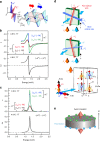Nonreciprocal responses from non-centrosymmetric quantum materials
- PMID: 30218054
- PMCID: PMC6138722
- DOI: 10.1038/s41467-018-05759-4
Nonreciprocal responses from non-centrosymmetric quantum materials
Abstract
Directional transport and propagation of quantum particle and current, such as electron, photon, spin, and phonon, are known to occur in the materials system with broken inversion symmetry, as exemplified by the diode in semiconductor p-n junction and the natural optical activity in chiral materials. Such a nonreciprocal response in the quantum materials of noncentrosymmetry occurs ubiquitously when the time-reversal symmetry is further broken by applying a magnetic field or with spontaneous magnetization, such as the magnetochiral effect and the nonreciprocal magnon transport or spin current in chiral magnets. In the nonlinear regime responding to the square of current and electric field, even a more variety of nonreciprocal phenomena can show up, including the photocurrent of topological origin and the unidirectional magnetoresistance in polar/chiral semiconductors. Microscopically, these nonreciprocal responses in the quantum materials are frequently encoded by the quantum Berry phase, the toroidal moment, and the magnetoelectric monopole, thus cultivating the fertile ground of the functional topological materials. Here, we review the basic mechanisms and emergent phenomena and functions of the nonreciprocal responses in the noncentrosymmetric quantum materials.
Conflict of interest statement
The authors declare no competing interests.
Figures






References
-
- Gardner M. The Ambidextrous Universe. Left, Right and the Fall of Parity. New York: Basic Books Inc.; 1964.
-
- Onsager L. Reciprocal relations in irreversible processes. I. Phys. Rev. 1931;37:405–426. doi: 10.1103/PhysRev.37.405. - DOI
-
- Landau, L. D.; Lifshitz, E. M. (1975). Statistical Physics, Part 1. Oxford, UK. Butterworth-Heinemann. ISBN 978-981-8147-790-3.
-
- Kubo R. Statistical-mechanical theory of irreversible processes. I. General theory and simple applications to magnetic and conduction problems. J. Phys. Soc. Jpn. 1957;12:570–586. doi: 10.1143/JPSJ.12.570. - DOI
-
- Rikken GLJA, Raupach E. Observation of magneto-chiral dichroism. Nature. 1997;390:493–494. doi: 10.1038/37323. - DOI
Publication types
LinkOut - more resources
Full Text Sources
Other Literature Sources

